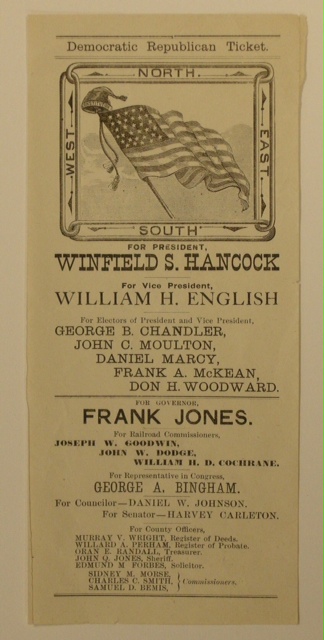23. Voting Methods
Located: 1st floor hallway near Courthouse and Federal Building linkPrints in courthouse exhibit: Democratic Republican ticket, printed for use in New Hampshire, 1880
Early American elections were conducted by voice vote. The physical presence of candidates and their supporters pressing hard for each vote, and their ability to hear each voter's decision, contributed to the unrefined nature of the era's electoral politics.
As the nineteenth century progressed, the use of paper ballots became more common. The lack of uniformity in handmade ballots led to charges of stuffing ballot boxes and difficulties in counting votes. As political parties became more prevalent, they printed and distributed ballots, known as party tickets, which listed only the sponsoring party's candidates. Although states regulated their size and paper weight, the parties used colorful ink to distinguish their tickets from others, making a voter's party choice obvious to any observer.

Voting Methods
Early American elections were conducted by voice vote. The physical presence of candidates and their supporters pressing hard for each vote, and their ability to hear each voter's decision, contributed to the unrefined nature of the era's electoral politics.
As the nineteenth century progressed, the use of paper ballots became more common. The lack of uniformity in handmade ballots led to charges of stuffing ballot boxes and difficulties in counting votes. As political parties became more prevalent, they printed and distributed ballots, known as party tickets, which listed only the sponsoring party's candidates. Although states regulated their size and paper weight, the parties used colorful ink to distinguish their tickets from others, making a voter's party choice obvious to any observer.
By the early 1900s, voters in most states used identical ballots that listed all candidates. This "Australian ballot" system ensured a degree of secrecy. Further, since each person received only one ballot at the polling place, voters could not easily vote more than once.
The introduction of mechanical voting methods in the twentieth century was intended to simplify the voting process with multiple candidates and referenda on a ballot. Today's voting technologies vary greatly across the country: Paper ballots, punch cards, and direct recording machines are all in use. Of course, even modern voting methods can be flawed, as exemplified by Florida's "hanging chad" controversy in the 2000 presidential contest.




